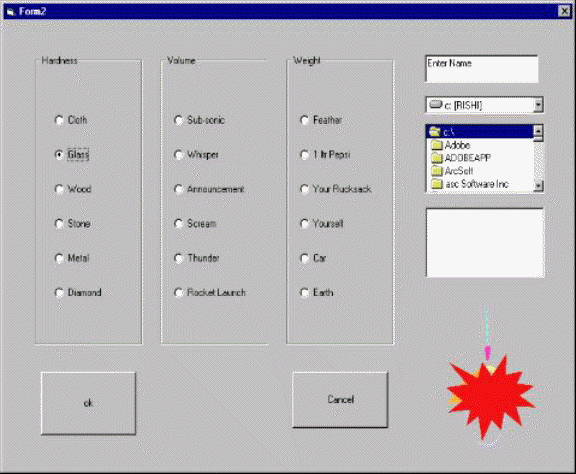
Sound Creator
The primary idea behind the Sound Creator is to have fun. The sound creator will enable the user to generate sounds very easily in a very interactive and fun manner. An important note is that the sounds may not culminate into something like a multimedia sound sequence. The point of note is that although you can use the software to create a sound sequence that is not the primary target of the software.
The software will now be described in great detail. The story of the software starts in a room, lets say my room. The room is full of everyday life objects. Objects that we see everywhere and hardly think worthy of our attention. Now, these objects can be used to generate all kinds of sounds. What if I were able to pick up the computer monitor and throw it against the radio. I cant do that in reality, but it is possible to do that in the software. The software will strive to get the right sound for all the object collisions, as close as possible.

What's more fun is that you can add your own objects too, objects too by selecting the add button. The sound generation will depend upon certain static parameters of the object like its weight, material, “tinniness” or sonority and then also some dynamic parameters like force (velocity, if you please) and the amount of blunt blow. The software will try to take all these parameters into account before you can generate sound. It would allow you to change the sound emanating from the objects. And what's more, the sound generation is not going to be symmetric. In other words, the sound generated when a chair is thrown against a table will be different from when the table is thrown against the chair, everything else being the same. The software, as I mentioned can allow you to add your own objects and you allot specific properties and an image to the object and give it a name.

also, after you have added the object, you can still change its properties by selecting the slider appearing below when an object is selected. At other times, when no object is selected, the slider and the buttons are hidden.

Besides adding stuff, you can delete the objects in the room by picking them up and dropping them into the trashcan. You can later retrieve them from the recycle bin in the room.
Another very interesting feature is a very natural extension of the whole idea. When objects bang against each other, they are supposed to break, right? Well, they do. And then the doctor repairs them. There is a big deliberation of putting the new button, the trashcan (delete) and the repair button in the room itself. It would be fun to see how the users would figure out the things. The whole idea is to be interactive and non-frustrating.

The room is also going to have variation of objects. They are not just going to be the dull objects we see everyday. There will be some really interesting objects like the alien, or pets and wild animals maybe. The alien can talk to you, eat the cake or the human or dance for you. The human in his turn can eat the alien, can scream, talk, walk, laugh or cry. The telephone can ring or be busy, the door can shut or close. The chair can screech against the floor and so can the table and the bed. The lamp can switch off or on. The wine can be poured, and so on. The ideas are limitless.

Besides some of these very obvious things the software would be capable of recording these sounds and then playing them later as a file. (most probably was file). The system will have two memories, a short term memory which will hold the last sound generated and the long term memory which will have the whole play record till the current point. The sounds will be in segments and each segment can be moved around freely, except the last one which will not be added till the next sound replaces it. The sound in the short term memory will be editable in the way that you could change its volume, intensity etc by jiggling with controls and then send it to the the long term memory.
Right now the project is still very immature and has lots of possibilities. It can be used as the interface of a virtual room, where things work the way they should. You could call up your friend using this phone and could listen to the news using the television set. You may probably have to wait for the wine, though!!!
Platforms targeted:
The project will be prototyped using Visual Basic 6.0. and the final implementation would be in Java Swing on desktop and Visual C++ on Win CE, pocket PC.
The project would aim to evaluate the following aspects of the toolkits: